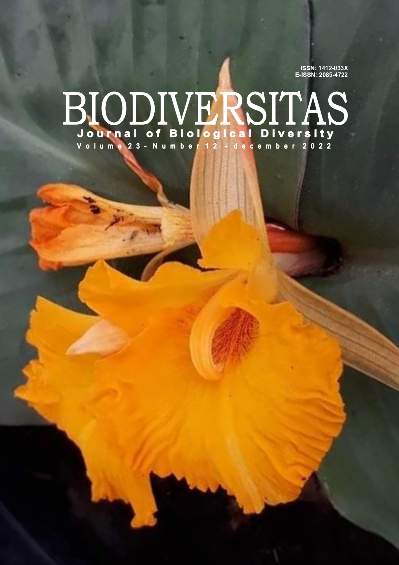Diversity and similarity of melon (Cucumis melo L.) groups and determination of distinguishing morphological characters
##plugins.themes.bootstrap3.article.main##
Abstract
Abstract. Saputra HE, Syukur M, Suwarno WB, Sobir. 2022. Diversity and similarity of melon (Cucumis melo L.) groups and determination of distinguishing morphological characters. Biodiversitas 23: 6254-6261. Characterization is an important activity for the study of genotype diversity and similarity. The study was aiming at obtaining information about the diversity and similarity of melon groups and to determine morphological characters as differentiators between melon groups. The genotypes tested were IPB240, IPB283, IPBM21, IPBM23, IPBME5, IPBMETA9, UME20, UME38, UME39, UME90, UME91, UME98, UME99, UME100, UME101. Characterization was based on UPOV and IPGRI guidelines for qualitative and quantitative characters. Two qualitative characters showed no variation in all tested genotypes, namely sex expression (EK) and secondary skin color outside the groove (WKSDA). Qualitative characters that have high diversity were groove color (WA), maximum width between grooves (LMAA), groove color intensity (IWA), and flower stalk thickness (KTBN). The UME98 genotype had the most different color appearance from the other genotypes on the heatmap. The color and depth of fruit grooves are distinguishing characteristics of all genotypes. There were genotype differences in the inodorus and reticulatus types. Unlike the IPBMETA9 genotype, UME100, UME101, and UME38 formed the same clusters with the characteristics of the makuwa group. Melon group makuwa had different characteristics with the inodorus and reticulatus groups. The distinguishing characters for the makuwa type were groove depth, ratio length to diameter, the diameter of hermaphrodite flower stalks, fruit diameter, and fruit skin thickness. Melon groups in the inodorus and reticulatus groups had high similarities, making it difficult to find specific characters in all melon genotypes observed.
##plugins.themes.bootstrap3.article.details##
Most read articles by the same author(s)
- MIRA SINTIA, SINTHO WAHYUNING ARDIE, WILLY BAYUARDI SUWARNO, Genetic variability of F2 foxtail millet population derived from ICERI-5 and Botok-10 cross , Biodiversitas Journal of Biological Diversity: Vol. 24 No. 6 (2023)
- NELLY MARLIANI, I MADE ARTIKA, MOHAMAD RAFI, MUHAMAD SYUKUR, RONNY YUNIAR GALINGGING, WARAS NURCHOLIS, Phenolic and flavonoid content with agro morphological characters of 12 accessions of Justica gendarussa grew in Indonesia , Biodiversitas Journal of Biological Diversity: Vol. 23 No. 10 (2022)
- NOVIAN LIWANDA, MUHAMAD SYUKUR, WARAS NURCHOLIS, Impact of genotype and harvest age on the polyphenol content and antioxidant capacity of okra (Abelmoschus esculentus) in Indonesia , Biodiversitas Journal of Biological Diversity: Vol. 25 No. 12 (2024)
- NIKEN KENDARINI, SYARIFAH IIS AISYAH, AWANG MAHARIJAYA, SOBIR, Photoperiod effect on vegetative growth and bulbing initiation of four garlic genotypes , Biodiversitas Journal of Biological Diversity: Vol. 23 No. 9 (2022)
- RAHMATUN NISFUL MAGHFIROH, WILLY BAYUARDI SUWARNO, SOBIR, ENDANG GUNAWAN, Assessment of relationship among traits and genotypes for melon (Cucumis melo) breeding , Biodiversitas Journal of Biological Diversity: Vol. 24 No. 8 (2023)
- SITI NURHIDAYAH, BAMBANG SAPTA PURWOKO, ISWARI SARASWATI DEWI, WILLY BAYUARDI SUWARNO, ISKANDAR LUBIS, Agronomic performance and selection of green super rice doubled haploid lines from anther culture , Biodiversitas Journal of Biological Diversity: Vol. 24 No. 2 (2023)

